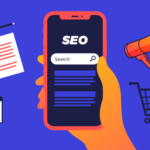This is a complete guide on e-commerce SEO for:
- SEO managers who are willing to enhance the ROI of SEO
- Small e-commerce business owners trying hard to take their online presence to the next level
- Growth marketer interested in driving more traffic
Although it is said that SEO has the highest ROI that is suitable for all e-commerce marketing campaigns, yet many online stores that barely have adequate knowledge about SEO here, Brainvire lets you know how you can use SEO to optimize your e-commerce stores.
Before getting into the strategies, take a quick look at what SEO is.
What is SEO, and why is it important?
In order to get a better ranking in Google’s search results, SEO or search engine optimization helps you to optimize your website around some particular keywords. Though a greater part of SEO relies on the technical side, some part of it demands innovative design and easy user-experience too.
SEMRush conducted a study researching 13 e-commerce sites. They found that 5 out of 13 sites were influenced by organic search, and 80% of the traffic was gathered in all the sites due to this. However, without any more facts and theories, let’s get straight into the steps that can be accommodated to optimize online stores.
Ecommerce is growing at a 5x rate than it was projected in the year 2020, and it has shown 77% growth altogether. For people who want to venture into e-commerce, there is a great opportunity to explore the market that is there.
Another thing that has changed is the website which offers an opportunity where they can win over the market share from their competition. The following statistics show the customer behavior in the current scenario.
- New e-commerce stores: 74% of shoppers purchase items that they would probably buy online.
- Older stores: Among the 7.4 million people who have reached the first online checkout (considering only the US), 75% are either new shoppers and older ages.
- 80% of the customers are more likely to purchase again from the same online shop regularly if they are able to get a customized shopping experience according to their personal needs.
The new shoppers that you will find today are more inclined towards looking out for necessities rather than for discretionary spending. One of the main complaints of the customers is that their items run out of stock, and they have difficulty in finding the items of their choice.
Moreover, they are shoppers who are tech-unsavvy and want a shopping experience that is faster, uncomplicated, and want something that is as per their immediate requirements. And such customers are ready to pay for the e-commerce store that will provide them such an experience.
So, if you get the personalization right on the very first visit of the customers, you will be able to see tremendous growth in your company over the years. If you aren’t to do that, you will lag behind your competitors at an exponential rate.
The search term is the first point of personalization where the shopper is arriving from a search. And using these search terms, the shoppers expect you to solve the problems that they are facing.
It is easy to do first-touch personalization in the physical shop as you can always go to customer support and specify your requirements to them depending on which you get the required treatment. For instance, you enter a body care shop and want a product for your hair.
First, you will be asked about the kind of hair you have and whether there is something specific that you are looking for.
So here are some of the things they we as a shopper would want from the store:
- Products should be in stock to solve the problem
- Staff to guide you through the various sections of the store and show you the most relevant ones.
- You are offered a good buying experience.
Achieving these feats is easy when you are working in a physical store and have real people who are running it.
But now, most of the shoppers have shifted to purchasing clothes online. The trend of physical retailing is almost dying, which has probably made the mall close off.
One way to overcome this problem is to provide first-touch personalization during the shopping experience that is especially applicable to the landing pages that are there on your website and personalize on just the one point of data, i.e., a search term.
Get FREE Digital Marketing Courses and Tutorials Here!
How does First-Touch Personalisation Work in Ecommerce?
Here are a few examples that will help you differentiate between traditional e-commerce teams that have succeeded in converting shoppers from the search term and the ones that use first-touch personalization.
Consider an online makeup products company that makes $80 million in revenue in a year.
Just by including first-touch personalization in their strategy, they can:
- Increase conversion rate by 98%.
- Customer acquisition cost (CAC) increased by 64%.
- Return on advertising spend increased by 169%
The results behind such improvements are well-known, and studies have shown that the average conversion rate increases when the pages that satisfy the shopper expectation increase by 108% and CAC reduces by 48%.
The before and after results are drastically different when customer experience is improved. Right before first-touch personalization was done, the landing page used to have just one product.
Due to this, shoppers started disliking the experience they were getting on the landing pages as they wanted to check out more options that could solve their issues and also because they could select, compare and buy whatever they want.
What can be done to optimize e-commerce stores?
#1 E-commerce keyword research
The first and foremost step that you should never miss out on in an e-commerce SEO campaign is keyword research. If you do not get this portion done thoroughly, it can lead to:
- Targeting the wrong keywords that too difficult to get a rank on Google’s page one
- Pick those keywords that do not drive too much traffic or pushes customers to buy
Neither of the situations is good for your online e-commerce website. To select the perfect keyword, you need to check out your buyers’ intentions. Now, you must wonder how you will conduct keyword research, know the buyers’ intent and find the keyword difficulty. For this, you have three ways – Amazon, Competitor Research, and SEO tools.
#2 E-commerce site architecture
Once you have the right keywords, you can move on to the next step – discussing the site’s architecture. The e-commerce site architecture is basically the structure of your site. In simple words, it is about how you organize the category pages, navigation, and product pages.
For creating a better e-commerce site, your goal should be to provide the users with the best and relevant content with the least possible clicks.
A great site architecture has two golden rules to be followed:
- It should be scalable and simple
- Getting to the other page should not take more than three clicks
- Make use of keyword research to craft relevant subdirectories and URLs
Also, do not forget to have adequate content on the homepage, as it allows you to enhance your rankings.
#3 On-page SEO strategy for e-commerce sites
If you have to make sure your keywords are placed rightly, you need the help of on-page SEO. Through on-page SEO, you inform Google what your online site is all about. Here, on-page SEO for e-commerce can be divided into:
- On-page SEO for e-commerce category pages
- On-page SEO for e-commerce product pages
- On-page SEO for your blog content
It is through on-page SEO that you can appear on SERP or Search Engine Results Page. To optimize category pages properly, your very first job should be to put the target keyword in the URL, in the title tag, in body copy, image alt text, and metadata.
For product pages, repeat everything you did for the category pages but with two major differences:
- No banner image is required since you already have the images of the product.
- Write one thousand words instead of merely 300.
This is because Google prefers pages that provide a lot of information that the ones that lack adequate content.
#4 Local SEO for e-commerce retailers
If you want more local traffic or have a physical store with the same brand name, you can boost it with local SEO. For this, you have to:
- Create Google My Business profile
- Build local citations
- Get local links
Create a proper Google My Business account with all your business’s details. This is worth trying because it allows users to get all the information that you want to spread about your business. Local citations and backlinks are the same as it shows your popularity on Google. Moreover, for building the overall website, any local links are useful.
Conclusion
There is no doubt that a majority of customers prefer personalization from the first moment itself.
The brands that don’t plan to adapt to digital transformation won’t be able to make it to the 2020s.
It was found that 67% of the global CEOs said they always put digital transformation at the center stage of their corporate strategy. Moreover, 35% of the resources in the IT sector will be able to create a completely new digital revenue stream.
So, there are so many ways to drive traffic to your online e-commerce website. If you want your site to reach the top of Google’s search results, you need to learn e-commerce SEO today!
Incorporate some simple SEO e-commerce strategies and see the difference.






